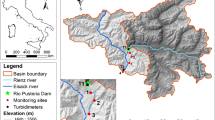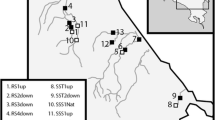Abstract
We examined benthic condition in three small watersheds in the Chesapeake Bay. Characterization of benthic condition was based on the combined measurements of benthic fauna, sediment toxicity, and sediment contaminant loads. Significant differences between watersheds were detected for sediment contaminant concentrations and water quality. The intensity of benthic impairment was greatest in the river surrounded by the most developed watershed. Spatial patterns of benthic condition were detected within all three watersheds. In contrast to current, intense focus on nutrient pollution in the Chesapeake Bay, qualitative comparison of our findings to land-use patterns supports findings of other studies that suggest benthic condition in tributaries of the Chesapeake Bay may more closely relate to urbanization than agricultural land uses.
Similar content being viewed by others
References
Bahner, L. (2006). Chesapeake Bay interpolator: v. 4.6. NOAA Chesapeake Bay Office, Annapolis, MD. Freeware, available at http://chesapeakebay.noaa.gov/interpolator.aspx.
Beach, D. (2002). Coastal Sprawl: The effects of urban design on aquatic ecosystems in the United States. Arlington, Virginia: Pews Ocean Commission.
Dauer, D. M., Weisberg, S. B., & Ranasinghe, J. A. (2000). Relationships between benthic community condition, water quality, sediment quality, nutrient loads, and land use patterns in Chesapeake Bay. Estuaries, 23(1), 80–96.
Diaz, R. J., & Rosenberg, R. (1995). Marine benthic hypoxia: A review of its ecological effects and the behavioral responses of benthic macrofauna. Oceanography and Marine Biology: An Annual Review, 33, 245–303.
Ecocheck (2007). Chesapeake Bay health report card, 2007. Available at http://www.eco-check.org/.
Fortner, A. R., Sanders, M., & Lemire, S. W. (1996). Polynuclear aromatic hydrocarbons and trace metal burdens in sediment and the oyster, Crassostrea virginica (Gmelin), from two high salinity estuaries in South Carolina. In F. J. Vernberg, W. B. Vernberg, & T. Siewicki (Eds.), Sustainable development in the southeast coastal zone (pp. 445–477). Columbia: University of South Carolina Press.
Fulton, M. H., Hyland, J. L., Key, P. B., Wirth, E. F., Balthis, L., Cooksey, C., et al. (2007). Characterization of toxic impacts on living marine resources in tidal rivers of the Chesapeake Bay. NOAA NOS NCCOS Technical Memorandum, 64, 80.
Hale, S. S., Paul, J. H., & Heltshe, J. F. (2004). Watershed landscape indicators of estuarine benthic condition. Estuaries, 27(2), 283–295.
Hall, L. W. J., Anderson, R. D., & Alden, R. W. I. (2002). A ten year summary of concurrent ambient water column and sediment toxicity tests in the Chesapeake Bay watershed: 1990-1999. Environmental Monitoring and Assessment, 76, 311–352.
Hartwell, S. I., & Hameedi, J. (2007). Magnitude and extent of contaminated sediment and toxicity in the Chesapeake Bay. NOAA NOS NCCOS Technical Memorandum, 47, 234.
Hyland, J. L., Balthis, W. L., Engle, V. D., Long, E. R., Paul, J. F., Summers, J. K., et al. (2003). Incidence of stress in benthic communities along the U.S. Atlantic and Gulf of Mexico coasts within different ranges of sediment contamination from chemical mixtures. Environmental Monitoring and Assessment, 81, 149–161.
Hyland, J. L., Van Dolah, R. F., & Snoots, T. R. (1999). Predicting stress in benthic communities of Southeastern U.S. estuaries in relation to chemical contamination of sediments. Environmental Toxicology and Chemistry, 18(11), 2557–2564.
Jordan, T. E., Weller, D. E., & Correll, D. L. (2003). Sources of nutrient inputs to the Patuxent River. Estuaries, 26(2A), 226–243.
King, R. S., Beaman, J. R., Whigham, D. F., Hines, A. H., Baker, M. E., & Weller, D. E. (2004). Watershed land use is strongly linked to PCBs in white perch in Chesapeake Bay subestuaries. Environmental Science and Technology, 38(24), 6546–6552.
Krahn, M. M., Wigren, C., Pearce, R. W., Moore, L. K., Boger, R. G., McLeod, W. D. Jr., et al. (1988). New HPLC cleanup and revised extraction procedures for organic contaminants (pp. 23–47). NOAA NMFS technical memorandum F/NWC-153.
Lerberg, S. B., Holland, A. F., & Sanger, D. M. (2000). Responses of tidal creek macrobenthic communities to the effects of watershed development. Estuaries, 23(6), 838–853.
Llanso, R. J., Dauer, D. M., Volstad, J. H., & Scott, L. C. (2003). Application of the benthic index of biotic integrity to environmental monitoring in Chesapeake Bay. Environmental Monitoring and Assessment, 81, 163–174.
Long, E. R., Field, L. J., & MacDonald, D. D. (1998). Predicting toxicity in marine sediments with numerical sediment quality guidelines. Environmental Toxicology and Chemistry, 17(4), 714–727.
McConnell, L. L., Rice, C. P., Hapeman, C. J., Drakeford, L., Harman-Fetcho, J. A., Bialek, K., et al. (2007). Agricultural pesticides and selected degradation products in five tidal regions and the main stem of Chesapeake Bay, USA. Environmental Toxicology and Chemistry, 26(12), 2567–2578.
MDE (2008). Statewide fish consumption guidelines for all ages. Available at www.mde.state.md.us. Accessed 15 May 2009.
NLCD (2001). National land cover data. United States Geological Survey website, www.usgs.gov. Accessed 5 January 2009.
Paul, J. R., Comeleo, R. L., & Copeland, J. (2002). Landscape metrics and estuarine sediment contamination in the Mid-Atlantic and southern New England regions. Journal of Environmental Quality, 31, 836–845.
Paul, J. F., Scott, K. J., Campbell, D. E., Gentile, J. H., Strobel, C. S., Valente, R. M., et al. (2001). Developing and applying a benthic index of estuarine condition for the Virginian Biogeographic Province. Ecological Indicators, 1, 83–99.
Pinkney, A. E., McGee, B. L., McGowan, P. C., Fisher, D. J., Ashley, J., & Velinsky, D. (2005). Using the sediment quality triad to characterize toxic conditions in the Chesapeake Bay (2002): An assessment of tidal river segments in the Bohemia, Elk, Northeast, and Severn Rivers (234 pp.). U.S. FWS Technical Report CBFO-C05-01.
Ringwood, A. H., DeLorenzo, M. E., Ross, P. E., & Holland, A. F. (1997). Interpretation of microtox solid phase toxicity tests: The effects of sediment composition. Environmental Toxicology and Chemistry, 16(6), 1135–1140.
Rutherford, D. W., Bednar, A. J., Garbarino, J. R., Needham, R., Staver, K. W., & Wershaw, R. L. (2003). Environmental fate of roxarsone in poultry litter. Part II. Mobility of arsenic in soils amended with poultry litter. Environmental Science and Technology, 37(8), 1515–1520.
Sanger, D., Blair, A., DiDonato, G., Washburn, T., Jones, S., Chapman, R., et al. (2008). Support for integrated ecosystem assessments of NOAA’s National Estuarine Research Reserves System (NERRS), volume I: The impacts of coastal development on the ecology and human well-being of tidal creek ecosystems of the U.S. Southeast. NOAA NOS NCCOS Technical Memorandum, 82, 72.
Siewicki, T. (1997). Environmental modeling and exposure assessment of sediment-associated fluoranthene in a small, urbanized, non-riverine estuary. Journal of Experimental Marine Biology and Ecology, 213, 71–94.
U.S. Census (2009). State and county quickfacts. Web based data tool. Available at http://quickfacts.census.gov/qfd/. Accessed 30 March 2009.
U.S. EPA (1998). Condition of the mid-atlantic estuaries (60 pp.). Technical Report: EPA/600/R-98/147, Office of research and Development, Washington, DC.
U.S. EPA (1999). Targeting toxics: A characterization report. A tool for directing management and monitoring action in the Chesapeake Bay’s tidal rivers. EPA Chesapeake Bay Program technical report. Available at http://www.chesapeakebay.net.
U.S. EPA (2007). Chesapeake Bay health and restoration assessment, 2007. EPA Chesapeake Bay Program technical report. Available at http://www.chesapeakebay.net.
Valiela, I., Foreman, K., LaMontagne, M., Hersh, D., Costa, J., Peckol, P., et al. (1992). Couplings of watersheds and coastal waters: Sources and consequences of nutrient enrichment in Waquoit Bay, Massachusetts. Estuaries, 15(4), 443–457.
Van Dolah, R. F., Jutte, P. C., Riekerk, G. H. M., Lewitus, A. J., Chestnut, D. E., McDermott, W., et al. (2002). The condition of South Carolina’s estuarine and coastal habitats during 1999-2000 (129 pp.). Technical Report 90, South Carolina Department of Natural Resources, Charleston, SC.
Williams, M., Longstaff, B., Buchanan, C., Llanso, R., & Dennison, W. (2009). Development and evaluation of a spatially explicit index of Chesapeake Bay health. Marine Pollution Bulletin, 59, 14–25.
Author information
Authors and Affiliations
Corresponding author
Rights and permissions
About this article
Cite this article
Leight, A.K., Slacum, W.H., Wirth, E.F. et al. An assessment of benthic condition in several small watersheds of the Chesapeake Bay, USA. Environ Monit Assess 176, 483–500 (2011). https://doi.org/10.1007/s10661-010-1599-9
Received:
Accepted:
Published:
Issue Date:
DOI: https://doi.org/10.1007/s10661-010-1599-9




